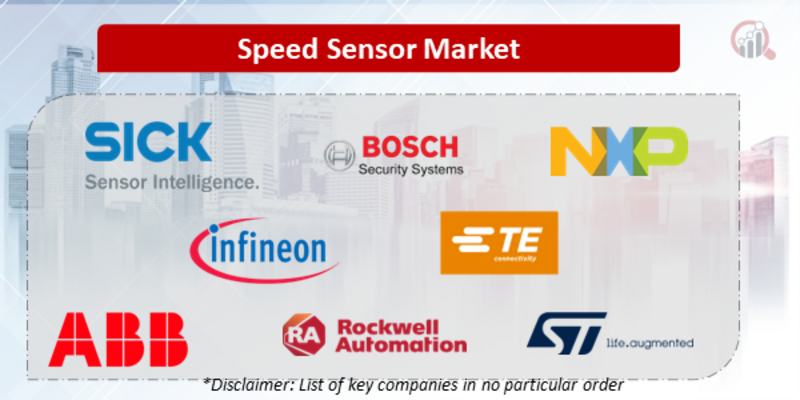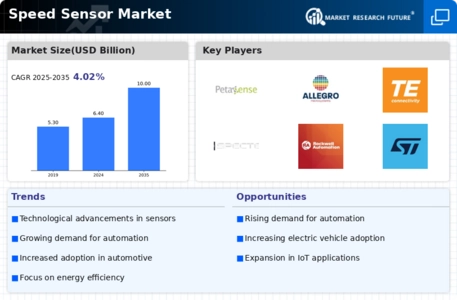Top Industry Leaders in the Speed Sensor Market

Competitive Landscape of Speed Sensor Market
The speed sensor market, a crucial segment of diverse industries like automotive, industrial, and renewable energy, pulsates with intense competition. Navigating this dynamic landscape requires a meticulous understanding of the key players, their adopted strategies, and the ever-evolving factors shaping market share.
Key Players:
- SICK AG
- Petasense
- Allegro MicroSystems, Inc.
- Robert Bosch GmbH
- NXP Semiconductors N.V.
- Infineon Technologies AG
- Sensoronix, Inc.
- TE Connectivity, Inc.
- SPECTEC
- Sensor Solutions Corporation
- ABB
- Rockwell Automation, Inc.
- STMicroelectronics
- Pepperl+Fuchs
- Schneider Electric
Strategies Adopted by Key Players:
To thrive in this competitive arena, companies employ a range of strategies. Product diversification is key, as catering to varied sectors and applications expands customer base. Technological innovation remains paramount, with players vying for advancements in precision, accuracy, and miniaturization. Building strong customer relationships and offering comprehensive after-sales service are crucial for brand loyalty and market penetration.
Market Leaders and their Playbook:
Established giants like Bosch, Continental, Denso, and NXP Semiconductors hold significant market share, leveraging their extensive experience, robust R&D capabilities, and global reach. Bosch, for instance, boasts a diverse portfolio catering to various applications, while Continental focuses on cutting-edge sensor technology for autonomous vehicles.
New Entrants:
Challenging the established order are niche players like TE Connectivity, Honeywell, and Omron, specializing in specific segments like magnetic encoder sensors or radar-based speed measurement. New entrants, often startups, inject innovation into the market with disruptive technologies like LiDAR sensors and MEMS-based solutions.
Market Share Analysis:
Analyzing market share necessitates consideration of factors beyond mere sales figures. Geographic distribution plays a vital role, with regional variations in demand and regulations influencing market dominance. End-use applications also impact share, as sensors for high-precision industrial robots differ from those in consumer fitness trackers. Additionally, factors like intellectual property ownership and supply chain efficiency can create competitive advantages.
Emerging Trends and their Impact:
The speed sensor market is constantly evolving, fueled by several key trends. The proliferation of autonomous vehicles drives demand for high-precision, reliable sensors capable of operating in diverse conditions. Industrial automation also presents significant opportunities, with increased adoption of robots and automated guided vehicles requiring advanced speed sensing solutions. Sustainability concerns are pushing for energy-efficient sensors, while miniaturization enables integration into smaller devices.
Industry Developments
SICK AG:
- December 12, 2023: SICK AG announced the launch of the Ruler2000 radar sensor, designed for high-precision speed and distance measurement in various applications, including traffic monitoring, robotics, and access control.
- November 15, 2023: SICK AG partnered with HERE Technologies to integrate its LiDAR sensors with HERE's real-time mapping platform for enhanced traffic monitoring and autonomous vehicle applications.
- October 26, 2023: SICK AG unveiled a new generation of LiDAR sensors, the LMS5xx series, offering improved performance and features for various industrial automation tasks.
Petasense:
- January 10, 2024: Petasense secured $40 million in Series B funding to expand its AI-powered LiDAR technology for traffic monitoring and smart city applications.
- December 5, 2023: Petasense partnered with HERE Technologies to deploy its LiDAR sensors in multiple European cities for real-time traffic flow monitoring and analytics.
- November 17, 2023: Petasense announced the launch of its new Traffic Insights platform, providing comprehensive traffic data and analytics to government agencies and transportation authorities.
